Content marketing has seen a lot of changes during the past few years.
Many of these changes can be attributed to the rapidly evolving search landscape as well as a huge shift in the way people are actually discovering content.
New, more sophisticated search algorithms, changes in how people use search engines, and new ways that marketers go about actually developing their content are just a few of the contributing factors and outcomes.
All that said, many marketers still experience the same pain points that were commonplace more than five years ago:
- "I struggle to measure the ROI of the content I create."
- We create great content, but we still don’t seem to rank high in Google for our target keywords."
- "So, I’ve done my keyword research. Now what?"
As a response to these problems — specifically the second one — a lot of marketers will create more and more content. Unfortunately, creating larger volumes of the same underperforming content will often result in the same underwhelming results — just at a greater expense.
In fact, adding more content to a poor existing site architecture can make it even harder for Google to find and rank your content. That’s not a situation any marketer wants to find themselves in.
The answer to these problems spans way beyond the number of blog posts being pushed out each week; the real problem lies in the way that most content strategies are being developed and organized.
SEO is evolving, and marketers need to change with it.
Fortunately, there are ways to overcome these obstacles and drive high-performing results for your marketing team.
Here, we’ll discuss the changing state of search and how marketers can keep up. Continue reading this page or use the links below to jump to a specific section.
Search Engines are Changing
Before we jump into solutions for finding success in the changing world of content marketing, let’s dive a bit deeper into the driving forces behind that change.
First, we need to chat about search engines. Updates to how search engines process and evaluate content have created drastic changes in recent years for SEO. As a result, the old metrics of success aren’t as reliable as they once were.
For example, one of the ways in which content producers evaluate the performance of content is by looking at keyword rankings within the search engines. However, there’s been a lot of debate around the actual credibility of keyword rankings as a metric, and the reason for this largely stems from the fact that rank changes depending on context.
To put it simply, depending on how and where you’re searching from, you’ll see different search results, which makes it difficult to evaluate success based on keyword rankings alone.
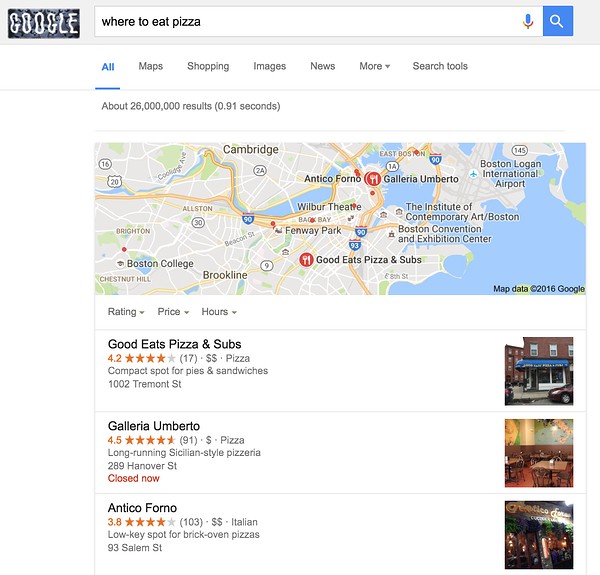
A simple search for the term “where to eat pizza” illustrates this perfectly. If you’re searching for this query from Boston, you’ll receive a completely different set of results compared to someone searching in San Francisco. In fact, the results page for this query probably has thousands of different variations at any one moment in time.
With this in mind, how do you accurately determine your ranking for this keyword?
Outside of keyword ranking problems, the search engines have also been dictating how content should be structured, most notably with the increased appearance of featured snippets.
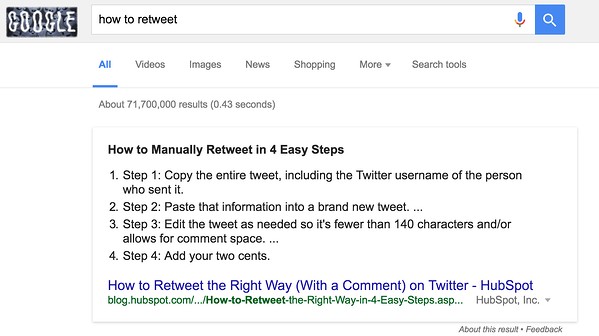
Google has been rolling out more and more featured snippets within the search results — one 2017 study found that of 1.4 million queries, 30% showed a featured snippet. These numbers have likely increased since then.
These boxes try to answer the question that the searcher has without them needing to navigate through to the content.
The reality is that content ranking within the featured snippet section often gets a much greater share of the traffic for the given query when compared to non-featured snippet SERPs.
Publishers now have to restructure their content to try and appear within these featured snippets, of which Wikipedia reigns supreme — owning an estimated 11.2% of all featured snippets.
On a more general level, Google in particular has been making big investments in machine learning and has introduced RankBrain into the core algorithm it uses to index and rank content. Ultimately, RankBrain enables Google to better understand the intent behind specific queries without the search query explicitly stating them — all with the goal of providing more relevant results to the searcher.
This brings us to the next big change in search: the searcher.
How People Search
More significant than the way in which search engines themselves are evolving is the way that searchers are communicating with search engines.
Amplified by the rise of mobile and voice search, queries have become more and more conversational. A few years ago many people entered fragmented terms into search engines. Now, it’s more common for people to ask complex questions using full sentences. Google’s updates over the past two to three years have focused on understanding these types of queries better through natural language processing, most notably with the rollout of Hummingbird in 2013.
The introduction of this new search algorithm, which began analyzing phrases instead of solely relying on keywords, marked a major switch for the search giant from keyword to topic-focused SEO. In 2016, Google CEO Sundar Pichai announced that one out of five queries on its mobile app and on Android devices were voice searches. Based on these new developments, the increasing importance of search topics shows no signs of slowing.
The takeaway here for content marketers? The traditional view of “keywords” in search has changed. Where a few years ago there were maybe 10-20 “big keywords” that would be sought after for ranking within a topic, there are now hundreds or thousands of long-tail variations that are regularly searched within a topic and change based on location. Simply dominating a few words is no longer enough to produce successful results.
Content Strategy in 2021 and Beyond
Considering the advancements in the ways that both the search engines and searchers are evolving, there needs to be a shift in the way marketers determine their content strategy — especially when focused on driving organic search.
The way we approach this at HubSpot is to look at our visibility across a topic, as opposed to a specific keyword. By organizing content within topic clusters instead of individual disjointed posts, we’re able to capture a large amount of search traffic across an ever-increasing pool of relevant keywords. This also allows us to align our brand with several recognizable core topics. Embracing the topic cluster model has allowed us to completely transform how we create and organize our content.
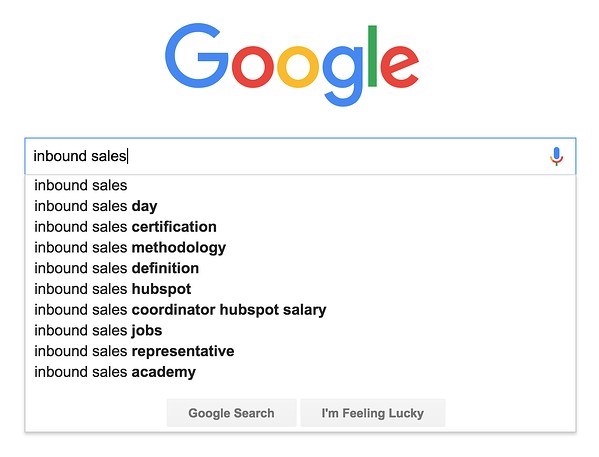
A great example of this is around “inbound sales," an area that we’ve been covering a lot. You can see from Google’s autocomplete section that there are a number of big links to HubSpot — with our Inbound Sales Day, Certification, and Methodology being the top three, as well as a direct mention of the HubSpot brand.
We’ve managed to align our brand with topics that directly relate to our buyer personas, and as a result of this topic cluster model, we generate millions of relevant visits to our web properties.
What's a topic cluster?
The basic premise behind building a topic cluster content program is to enable a deeper coverage across a range of core topic areas, while creating an efficient information architecture in the process.
You’re probably thinking, “This sounds difficult to implement? How can I start using this strategy for my own content marketing?” Don’t worry, it sounds more complicated than it really is.
In simpler terms, a pillar page is a broad overview of a specific topic. You can think of it like a summary or road map. We built pillar pages for each of our major focus areas. Linking into the pillar content is a range of content that covers individual, more specific subtopics, otherwise known as cluster content. Each cluster topic page for the pillar focuses on providing more detail for a specific long-tail keyword related to the main topic. The pillar links to each cluster page and each cluster page links back to the pillar with the same hyperlinked keyword.
The benefit of this model, in addition to organizing your site architecture, is that one high performing cluster page can elevate search rankings for all the other pages linked to the same pillar.

By aligning sets of web pages this way into topic clusters, you can manage the internal linking between each page more efficiently, boost your search ranking, and also provide a better user experience for visitors.

Building a solid information architecture is incredibly important for ranking well in organic search across a broad topic area. Creating hyper-focused clusters of content geared around a specific topic will not only help solve for that, but also enable you to keep focused on creating content that your target audience actually cares about. That means higher efficiency for your search marketing and less time wasted on producing repetitive content that doesn’t help advance your search goals.
The typical way to structure a topic cluster of content, which we outlined earlier, is with one larger piece of content that broadly covers the core topic, otherwise known as pillar content. Here’s an example to illustrate this:
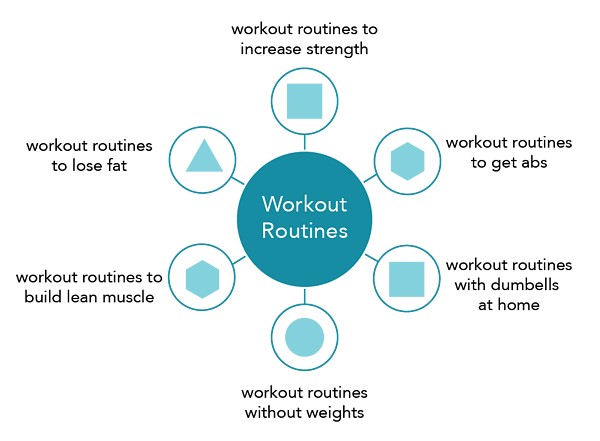
In the above example, the core topic is “workout routines.” Each of the surrounding subtopics focuses on a more specific branch of the core topic, for example, “workout routines to build lean muscle.”
The role of the pillar content is to cover the core topic broadly while also converting visitors into leads (or whatever your conversion goal is). The cluster organization also signals to search engines that the content has more in depth information on the topic, in turn giving your pillar page a higher level of authority on the topic while gaining higher search placement from orderly linking.
The beauty of this model is that you can spend a lot more time optimizing your pillar content for conversions and your cluster content for traffic. This saves a lot of time compared to the traditional model of optimizing each individual post. It also makes it easier for you to give a better user experience while sending a positive signals to the search engines with this site architecture.
For example, the typical organization of a blog may look like the below, with lots of overlapping and repetitive posts on a few focus topics:
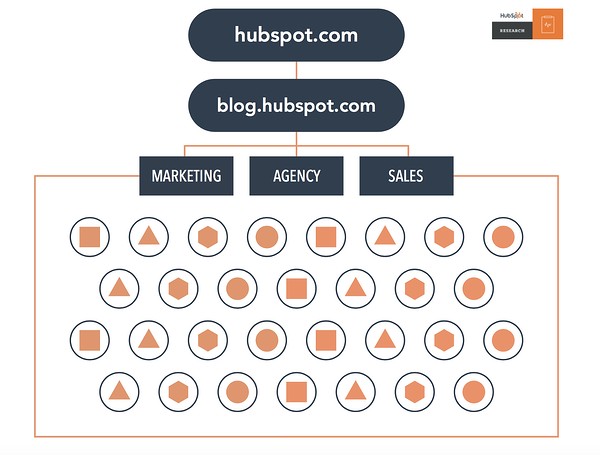
A blog using topic clusters would look like this, with multiple posts all linking back to their respective pillar pages for each core topic:
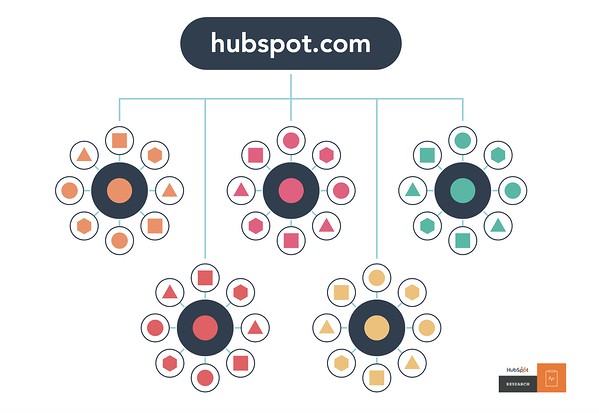 An example of pillar content that we’ve produced at HubSpot would be our Blog Topic Generator tool.
An example of pillar content that we’ve produced at HubSpot would be our Blog Topic Generator tool.

This pillar content brings in a substantial amount of new leads every month and gets a considerable amount of traffic. Tools work particularly well for pillar content because they’re often evergreen content and get shared a lot.
We’ve built out a wide range of cluster content that ties into specific subtopics. An example of this would be our blog post titled, “How to Think Up a Year's Worth of Blog Post Topics in an Hour,” which has an internal link pointing to the Blog Topic Generator tool. For more inspiration, check out these great pillar page examples.
This content will drive traffic to the pillar content and push positive link signals to the search engines in the process, increasing both the organic search visibility and leads generated from the overall topic cluster.
How to Create a Topic Cluster Plan
Before you get started creating new topic clusters of your own it’s important to determine if this is the right approach for your site. You can figure this out by asking yourself three simple questions outlined in the chart below.
- Does the topic you want to rank for have enough search volume to be worth the time and effort?
- Do you already have content covering the topic? If so, you may be better off using what you have and adding internal links.
- Is the topic something you want to cover in detail? If you’ve made it this far and the answer is “yes”, you can start creating your own topic cluster.
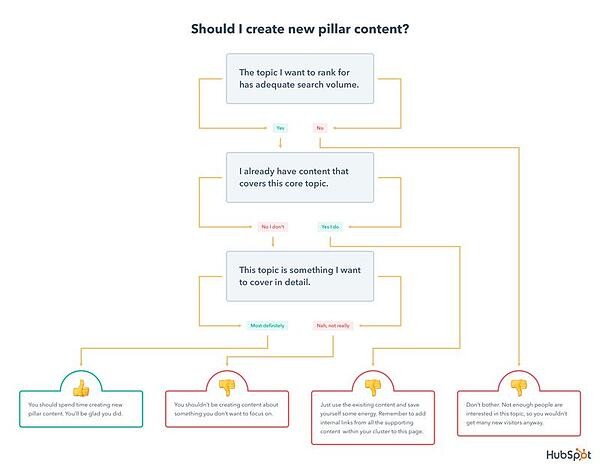
When it comes to actually mapping out topic clusters, there’s a general process that works particularly well. Follow these steps to create your own pillar page:
- Map out 5-10 of the core problems that your buyer persona has (use surveys, run interviews, and do some secondary research within online communities).
- Group each of the problems into broad topic areas.
- Build out each of the core topic with subtopics using keyword research.
- Map out content ideas that align with each of the core topics and corresponding subtopics.
- Validate each idea with industry and competitive research.
- Create, measure, and refine.
This is a simple overview but should help you to begin to prioritize content ideation and production. Following this process will help you to structure your editorial calendar for the topic cluster content model.
But how do you figure out what content to focus on? This is where keyword research comes into play. Keyword research is a helpful way to determine what content your target audience already is looking for so you can reach them in a way that is relevant and impactful to them.
To get started, create a list of broad topics that are important to your business. Then fill in each topic with potential keywords you think your audience will search for. It’s better to not self-edit during this stage and write out as many keywords as you can think of. For example, if your main topic is Instagram marketing, your subtopics might include Instagram business accounts, Instagram captions, Instagram hashtags, and Instagram analytics.
Once you have your list, search for these terms or use a tool such as Ubersuggest to find related keywords and terms you may not have initially included in your list. Make sure you have a mix of long-tail and short-tail keywords.
Now that you’ve finalized your keyword list, see how your competitors rank for each of them using a service like SEMRush. This will allow you to find gaps in their search strategy as well as single out important words and phrases to aim for in the pillar content you create. After all of those steps are complete, use Google’s Keyword Planner or HubSpot’s keywords tool to narrow down the keyword list.
Once you’ve developed your core topic and cluster content, create a tracking document to keep track of your existing content and cluster strategy. Tracking documents can help organize your clustering process to make sure all of your content has been linked correctly. For HubSpot customers, you can automate clustering using HubSpot’s content strategy tool.



